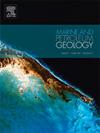Structural evolution of anticlines over the Hendijan Paleo-High in the northwestern Persian Gulf: Insights into the influence of inherited basement faults
IF 3.7
2区 地球科学
Q1 GEOSCIENCES, MULTIDISCIPLINARY
引用次数: 0
Abstract
The major prolific oil fields of the Persian Gulf, located within the foredeep basin of the Zagros fold-thrust belt, have developed over north–south-trending paleo-highs formed by the reactivation of inherited basement faults. One such structure in the northwestern Persian Gulf is the Hendijan Paleo-High, over which the Hendijan, Bahregansar, and Abuzar anticlines have evolved. In this study, we investigate the structural style and progressive evolution of these anticlines through seismic interpretation, chronostratigraphic analysis, structural cross-section construction, and sequential tectonostratigraphic restoration. Our findings reveal three phases of deformation and paleo-high development, each corresponding to major tectonic events along the northeastern margin of the Arabian Plate. The first phase, recorded by growth strata within the Triassic succession flanking the Hendijan Anticline, corresponds to the onset of Neo-Tethys rifting. The second phase, involving approximately 0.5 % shortening, marks the initial formation of the Hendijan Paleo-High. Growth strata, a basal unconformity, and thickness variations within the Late Cretaceous Sarvak Formation—synchronous with the obduction of Neo-Tethys ophiolites onto the passive margins of both the Zagros and Oman—provide evidence for this phase. The third phase, associated with less than 2.3 % shortening, produced growth stratification within the Aghajari Formation during the Arabian–Central Iranian continental collision, as the deformation front advanced into the northwestern Persian Gulf during the Pliocene. We propose that reactivation of the Hendijan–Bahregansar–Nowrouz basement fault during the Late Cretaceous initiated trishear folding in the overlying strata, driving uplift of the Hendijan High and facilitating vertical hydrocarbon migration from source to reservoir. This process likely contributed to the long-term preservation of petroleum accumulations.
波斯湾西北部亨迪扬古隆起背斜的构造演化:对继承基底断裂影响的认识
波斯湾主要高产油田位于扎格罗斯褶皱冲断带的前深盆地内,是在继承基底断裂重新活化形成的南北向古隆起上发育的。波斯湾西北部的一个这样的构造是亨迪扬古隆起,在其上演化出了亨迪扬、Bahregansar和Abuzar背斜。本文通过地震解释、年代地层分析、构造剖面构造和序贯构造地层恢复等方法,探讨了这些背斜的构造样式和演化过程。我们的发现揭示了阿拉伯板块东北缘的三个变形和古隆起发育阶段,每个阶段都对应着阿拉伯板块东北缘的主要构造事件。第一阶段,由三叠纪演替中的生长地层记录,位于亨第扬背斜两侧,对应于新特提斯裂谷的开始。第二阶段,大约缩短了0.5%,标志着Hendijan古高压的初始形成。晚白垩世Sarvak组的生长地层、基底不整合和厚度变化——与新特提斯蛇绿岩向Zagros和阿曼被动边缘的逆冲同步——为这一阶段提供了证据。第三阶段,缩短幅度小于2.3%,在上新世阿拉伯-伊朗中部大陆碰撞期间,随着变形锋向波斯湾西北部推进,在Aghajari组内产生了生长分层。我们认为,晚白垩世Hendijan - bahregansar - nowrouz基底断裂的重新激活,在上覆地层中引发了三剪切褶皱,推动了Hendijan隆起,促进了油气从源向储的垂直运移。这一过程可能有助于石油聚集的长期保存。
本文章由计算机程序翻译,如有差异,请以英文原文为准。
求助全文
约1分钟内获得全文
求助全文
来源期刊

Marine and Petroleum Geology
地学-地球科学综合
CiteScore
8.80
自引率
14.30%
发文量
475
审稿时长
63 days
期刊介绍:
Marine and Petroleum Geology is the pre-eminent international forum for the exchange of multidisciplinary concepts, interpretations and techniques for all concerned with marine and petroleum geology in industry, government and academia. Rapid bimonthly publication allows early communications of papers or short communications to the geoscience community.
Marine and Petroleum Geology is essential reading for geologists, geophysicists and explorationists in industry, government and academia working in the following areas: marine geology; basin analysis and evaluation; organic geochemistry; reserve/resource estimation; seismic stratigraphy; thermal models of basic evolution; sedimentary geology; continental margins; geophysical interpretation; structural geology/tectonics; formation evaluation techniques; well logging.
 求助内容:
求助内容: 应助结果提醒方式:
应助结果提醒方式:


